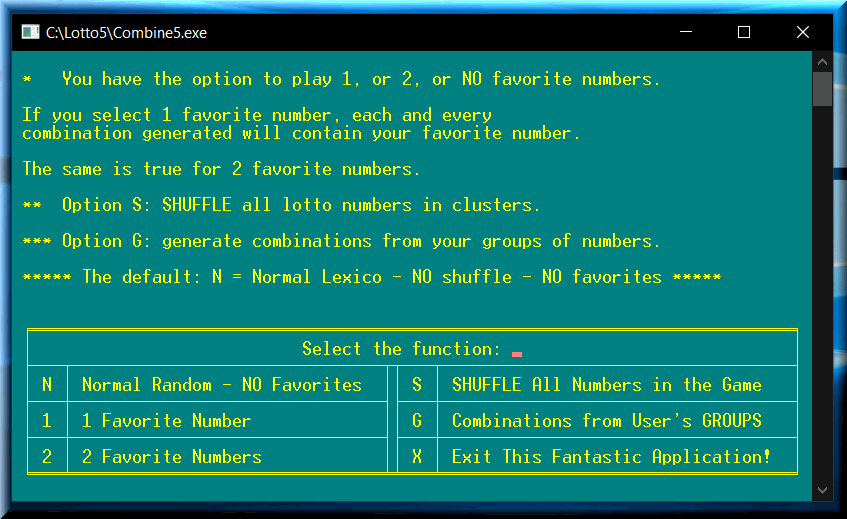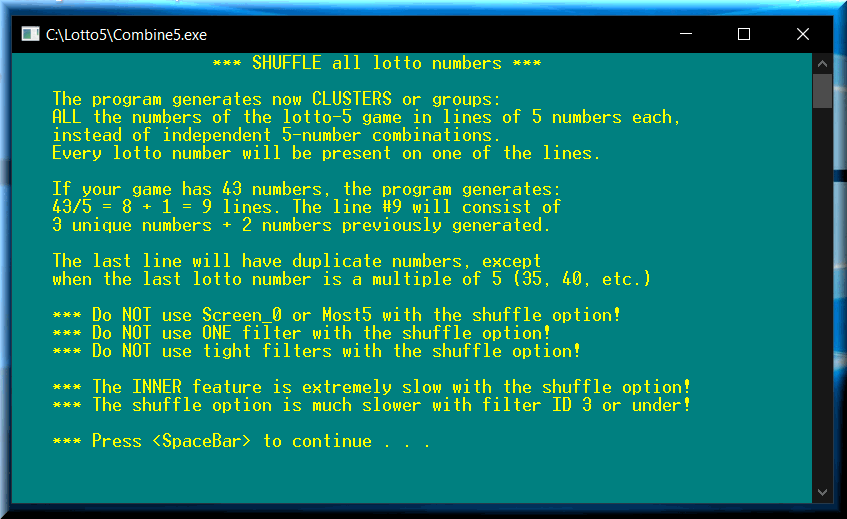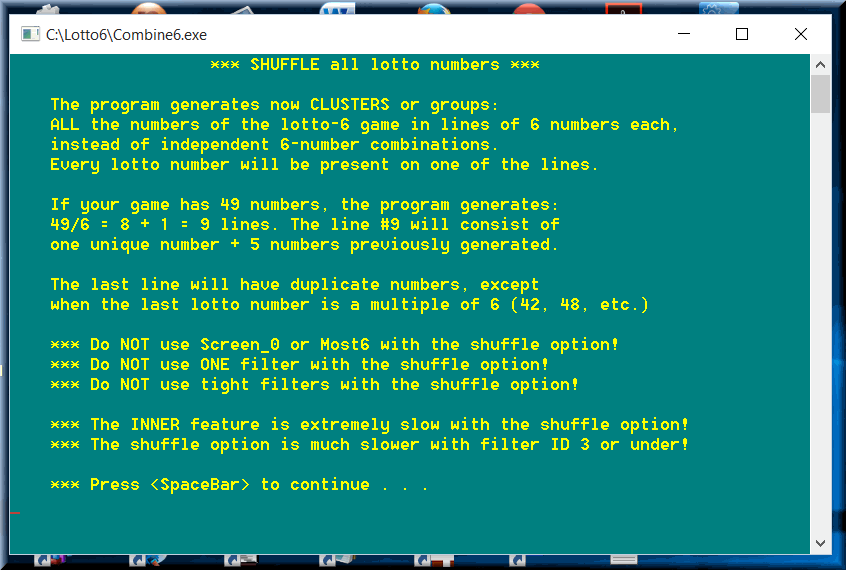
Professors Play All Lotto Numbers and Win UK National Lottery Jackpot
Sudoku Lotto or Lotto Sudoku?
By Ion Saliu, ★ Professor Emeritus of Lottery Mathematics



It happened on October 21, 2006 in The United Kingdom National Lottery. It generated some buzz around the world because, reportedly, the lotto players were also professors! The players themselves stated that they used mathematics in designing their strategy. Actually, only one or two of the lottery club members were real professors...
They had organized a lottery syndicate. The syndicate consisted of 17 staff members at Bradford University and College in Britain. The group started playing lotto together since 1994. They hadn't had spectacular success up until this year. They applied their winning strategy (playing all the lotto numbers) for the past four years only.
Apparently, they played 17 tickets (17 lotto-6 combinations) in the 6 of 49 lotto game played in Britain. That amount of tickets - 17 - looks somehow odd (pun intended)!
I'll tell you the real mathematical story right here. I have been doing similar lottery strategies since the early 1990s. I call this type of lotto playing SHUFFLE. Nobody contests the fact that I was the first lottery analyst to come up with the idea and also the software. Matter of fact, my lotto shuffling software is still the only one sporting the feature.



It resembles shuffling a deck of cards. All the cards remain in the deck. In my shuffling method, all lotto numbers remain in the deck, as it were. We play the numbers in 9 groups of 6 numbers apiece (the case of 6 from 49 lottery game). If we play only 8 tickets, we miss one number: 49. Thus, we add lotto number 49 in the 9th line, and then complete the ticket by adding five numbers previously selected. The simplest method is shown - but it is strongly recommended not to play such tickets!
1,2,3,4,5,6
7,8,9,10,11,12
37,38,39,40,41,42
...
49, 1, 8, 15, 22, 30
I also released special software to handle lotto shuffling. The programs have been freeware since no later than 1994:
SHUF-5
SHUF-6
The two lotto programs are no longer available as standalone as they were superseded by far more potent functions. The shuffling feature was added to far more powerful software. The improvement went even higher: The Bright lotto software packages. Beginning 2015, the Ultimate Lottery Software applications came to fruition.
Shuffling all lotto numbers is present in the Combine programs. Here is a good example of playing all lotto 6/49 numbers as generated by Combine6 (the S = Shuffle option):
Cluster #1:
25 43 41 47 32 3
2 20 12 8 33 14
27 31 24 16 36 22
6 48 15 9 4 29
13 11 1 46 17 23
7 18 34 44 42 19
10 26 35 38 5 49
39 21 37 45 28 40
30 25 20 24 4 23
The cluster represents the group that contains all the lotto 6 of 49 numbers, which are unique, except for the last ticket. The last combination repeats 5 of the lotto numbers previously generated: 1 number from line #1, 1 from line 2, 1 from line 3, 1 from line 4, and 1 from line #5. By the way, none of the lines in the cluster above repeat any 6-number groups from past lotto drawings. Past drawings do not repeat in hundreds of thousands, even millions of combinations sometimes in delta format inclusively.
I am NOT saying that the British syndicate used my lottery strategy. I did NOT expressly give any player or group of players exact strategies of applying the lotto shuffle. But they might have had knowledge of the shuffle feature in my lotto software. Chances are good for that happening. My lottery software has a pretty large following worldwide. A number of visitors are referred to my Web site via searches such as sixline lotto or ion saliu six-line lottery groups or lotto shuffle or play all lotto numbers.
Of course, IP addresses can be matched in the Web server log files for quite some time back. I want to stress that my software was totally free no strings attached basically until 2007. It was free you won, all winnings were yours. Besides, the shuffle strategy applied by the professors is quite illogical. Why 17 tickets? Just 9 6-number combinations were needed. If they played two clusters, then 18 lotto tickets should have been played. Looks like they eliminated the last line in the second cluster so that every player played one ticket! Lucky they didn't eliminate the winning ticket!
Or, perhaps, they were very efficient! A lotto 6/49 cluster consists of 8 6-number combinations. So they added two clusters to have 16 full 6-liners. The line #9 in each cluster consists of one number. They put together the two numbers in the last lines and added 4 more unique numbers. Thus, they came up with 17 tickets or one ticket per player. Payment-wise, that is; they played the tickets together.
The story reopened my appetite for my shuffling strategy. Granted, the early computers were inept at handling this type of combination generating strategy. The computer must be adequately fast to handle such a daunting task. Generating all the lotto clusters in lexicographic order involves very complex mathematics and very difficult computer science. Even the fast computers of today allow for random generation only; hence the term shuffle.
I run a faster computer now. I can still use a faster PC! The lotto combination generator is slow even for cases with multiple-hit strategies. The good news is that the computers are getting much faster by the year.
I have a lottery data file (D6) with over 12,000,000 combinations (12 million for a 6/49 lottery game). Most of you know that a D6 file consists of lotto-6 real drawings (past winning numbers) on top of thousands or millions of SIMulated lotto draws. I remember a time when the personal computers could barely handle data files with only 100 drawings!
My lotto software has this drawback that I fixed in version 4.0 of MDIEditor And Lotto WE: Inner filters. The inner filters cannot be disabled by the user. The frequency allowed by the inner filters is adequately statistics-wise - but not 100%. The combination generators can eliminate all combinations in the D6 file - and then some. Deltas (differences between adjacent lotto numbers) are applied to the past drawings as well. For example, this is a combination in the D6 lottery file (real results plus simulated combinations):
6, 13, 26, 33, 38, 48
The following combinations will be eliminated (plus more):
6, 13, 26, 33, 38, 48
5, 12, 25, 32, 37, 47
7, 14, 27, 34, 39, 49
The winning lotto numbers were: 15, 18, 23, 31, 37, 49.
The combination passes the inner filters in LotWon lotto software or the inner filters in MDIEditor Lotto.
IS

That puzzle or game that I don't care about Sudoku certainly shows resemblance to my lotto clusters. (No debate, the Sudoku thing came big to life a few years after my lotto clustering or shuffling software was offered as shareware in 1990-1991. Sudoku came to prominence in 2005. All the numbers in the cluster (or 9x9 Sudoku grid) are unique. My old-timer lotto buddies did not miss the resemblance. Of course, they wanted me to write the best software there is to generate every possible Sudoku grid (one trillion?) But what for?! I'd rather write software to generate every possible lotto cluster the effort can be worth millions, if not billions, of dollars over time.
The number of unique lotto clusters (groups containing all lotto numbers, all unique) is gigantically higher than total possible Sudoku grids. Today's computers are simply babies who can't walk, while asked to run Olympic dash races against adults! I offered some accurate calculations regarding the number of possible lotto wheels transpositions (rotations, etc.) Read:
The calculation of total lotto clusters involves the factorial (e.g. 49!). Today's computers can only generate random lotto clusters. Generating lexicographic clusters would take many, many years. My probability program Shuffle can also generate lotto clusters. The probability software also shuffles all lotto numbers and randomly arranges them in one vector (line). The 49-number vector, for example, can be broken into 7 lines of 7 numbers each. Thus, a 49-number vector was converted to a 7-by-7 matrix.
My combinatorial software PermuteCombine might be the only program today capable of generating every possible Sudoku grid. Actually, the Arrangements function in PermuteCombine is capable of such a daunting task (provided that a capable computer is available).
If you want to play with Sudoku why so often? Wouldn't be a whole loto more rewarding to play with the all-lotto-number clusters? You can even eliminate 6-number combinations that came out in the past: The probability for their repeating is negligible in a lifetime. Meanwhile, playing all-lotto-number clusters offers a far-better-than-negligible chance to win big money.

Resources in Lottery Software, Lotto Wheeling

Home | Search | New Writings | Fundamental Formula | Odds, Generator | Contents | Forums | Sitemap
